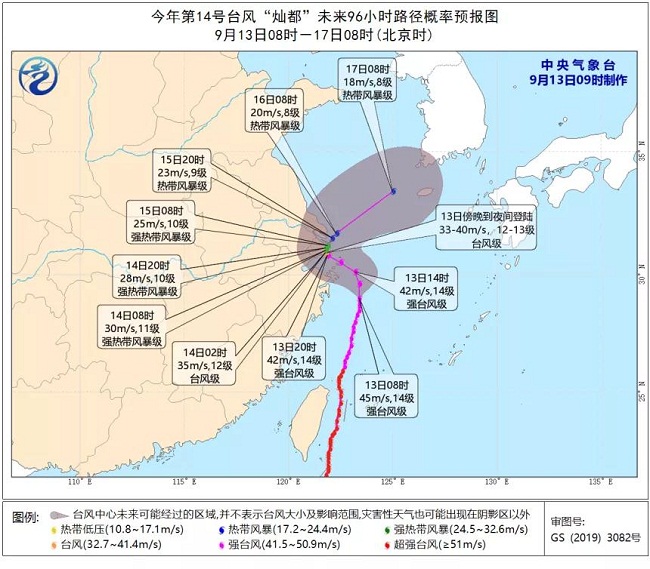Jiaxing upgrades typhoon response to highest level

The path of typhoon Chanthu from the National Meteorological Center from 8 am on Sept 13 to 8 am on Sept 17. [Photo/WeChat account: jxfabu]
Jiaxing in East China's Zhejiang province upgraded its emergency response to the highest level on Sept 12, closing schools and scenic spots as well as suspending air and rail services.
The center of the 14th typhoon of the year Chanthu was about 308 kilometers southeast of Jiaxing at 9 am on Sept 13, packing winds of around 45 meters per second, according to the local municipal meteorological observatory.
Currently, Chanthu is moving northward at a speed of 20 km/h with weakening strength. It is expected to move northeast after Sept 15.
The observatory said that the typhoon is expected to make landfall in the province's coastal areas between Zhoushan and Ningbo, or pass through Zhoushan Islands Monday morning. The storm is forecast to bring heavy rain and strong gales to Jiaxing from Monday to Wednesday.
Education authorities in the city have ordered suspension of classes in kindergartens, primary and high schools, and off-campus training institutions on Monday.
All the scenic spots in the coastal areas of Jiaxing have been closed and part of the buses and coaches in the city have also been suspended.
Here are some do's and don'ts before and after a typhoon.
Before a typhoon:
Keep an eye on the latest pre-warnings and predictions for the typhoon.
Halt mass gatherings, aloft work, and operation at sea.
Vessels operating at sea should return to port as soon as possible.
Consolidate or dismantle unauthorized structures.
Do not go out and people in low-lying areas or dilapidated buildings should move to a safer place.
Close doors and windows and move potted plants and other outdoor articles into the house.
Check electric circuits and gas piping and reserve some emergency food if necessary.
Keep an eye on possible torrential floods and other geological disasters.
During a typhoon:
Do not shelter from the rain under a tree, an iron tower, or an advertising board.
Do not swim or boat on rivers.
Turn off electrical equipment and cut off unnecessary power supply.
Park the car in an underground parking lot and make sure the parking lot's drainage system is unobstructed.
After a typhoon:
Clean up to prevent the spread of hazardous substances and germs.
Discharge water, harvest, and plant crops to reduce agricultural losses.


 Red boat spirit inspires new developments
Red boat spirit inspires new developments Zhejiang: A Decade of Progress
Zhejiang: A Decade of Progress A look at Jiaxing's H1 economic data
A look at Jiaxing's H1 economic data